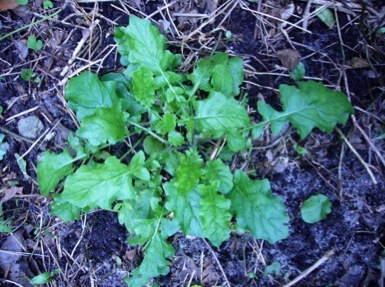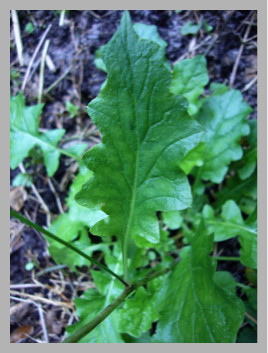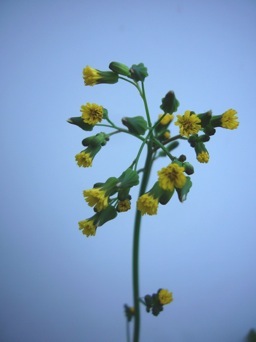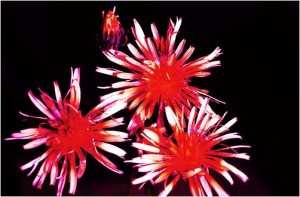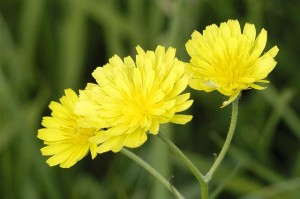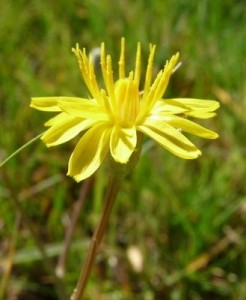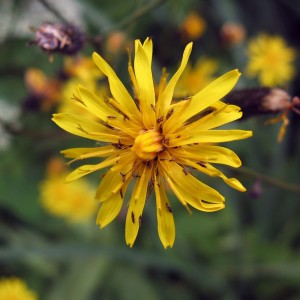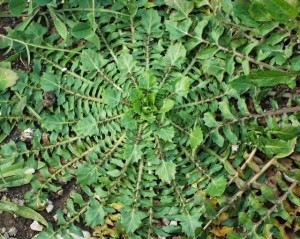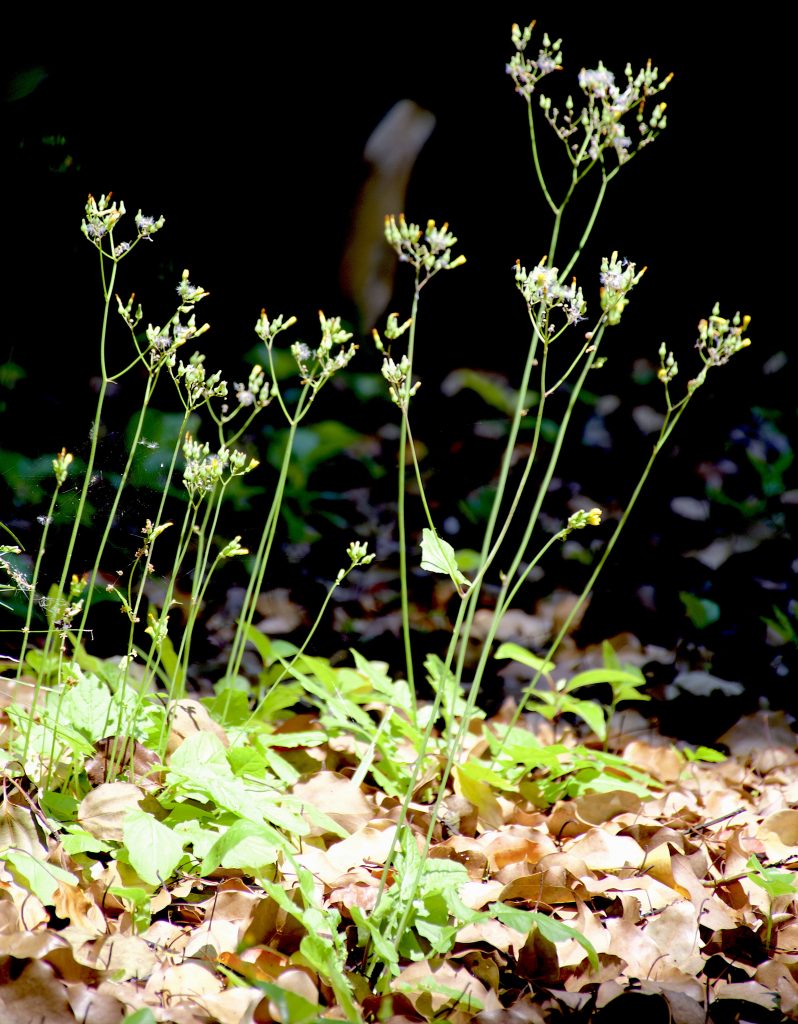
False Hawk’s Beard can have blossoms in all stages. Photo by Green Deane
Crepis Japonica: Seasonal Potherb
If the Crepis fits….wear….ah…eat it
Crepis japonica gets no respect. When I wrote this original article seven years ago you couldn’t find Crepis japonica in field guides on edible plants. And there was very little of substance about it on the Internet other than its name. The same can also be said for its edible cousins, Crepis setosa, Crepis runcinata, Crepis glauca, Crepis capilaris, Crepis bursifolia, Crepis vesicaria and Crepis tectorum. My point, there’s an edible Crepis near you.
All these Crepis have little variations, and some are more or less bitter than the others, but they are found across North America, Europe and Asia. For such an edible group they are barely known. While this article is about the Crepis japonica there is in North America: Crepis capilaris, the Smooth Hawksbeard which is found in most northern states; Crepis glauca or Crepis runcinata, the Fiddle Leaf Hawksbeard which is found along the Rocky Mountains through the United States into Canada; Crepis tectorum, the Narrow Leaf Hawksbeard which is found in the upper half of the United States and Canada; Crepis setosa, the Bristly Hawksbeard, found in a smattering of states of no particular pattern; Crepis vesicaria, the Beaked Hawksbeard, which is found along both coasts of the United States, and Crepis bursifolia, the Italian Hawksbeard, which is found in California, and Europe. Crepis japonica is found from about Pennsylvania south in to the South and west to Texas, also in Asia. What can be said of one, applies to the others and they are used in similar ways.
My local Crepis, C. japonica (KREP-is juh-PAWN-ih-kuh) might not get much attention because they changed its name from”Japanese sandal” which was kind of cute, to ” Japanese Young” or Youngia japonica (YOUNG-ee-ah) honoring which botanist I’ve never been able to find out.) Also being called the Oriental False Hawksbeard doesn’t help. But no matter what you call it, or them, the plants do just fine and are excellent potherbs.
Personally, I prefer the name Crepis japonica than Youngia or hawksbeard. Youngia sounds a bit contrived and I have always associated “hawksbeard” with a totally different plant in a different area of the country.
As for the word “Crepis” we know that Theophrastus, the immediate successor to Aristotle in Athens, mentioned the plant by this name some 2,300 years ago, as did Pliny some 400 years later in Rome. But English-speaking botanists say they don’t know why the genus was named Crepis. They use the phrase “lost to history” to explain that when perhaps they should admit they are linguistically challenged: Knowing a non-speaking, dead form of writing — Latin — doesn’t count towards linguistic proficiency.
Three possibilities are usually offered in English for the word “crepis” (krepis) two of which are not convincing. The first definition is that it describes a step at ancient Greek temples, what we would call a fancy doorstep. I have not been able to confirm “Krepis” ever referred to a temple step, and neither can a Greek professor of Greek I know
A more common ascription is that “krepis” means slipper or sandal, some say boot. Again, research in Greek does not bear that out. But it is getting closer. A secondary use of “krepis” in non-demotic Greek is for the soft leather that makes up the soul of a shoe, back when shoes were more like pointy moccasins. And if you have fantastic eyesight and imagination the seed of the C. japonica might look like a slipper or a sandal. But that is looking very hard for an answer.
The primary use of the word “krepis” in non-demotic Greek was for a textured light cloth that had various uses including veils. From there it went into Dead Latin as “crispus, or, “crisp” meaning curled and wrinkled. Then to French and lastly to English as “crepe” as in “crepe paper.” And indeed the leaves of the C. japonica and the rest, are curled and wrinkled. Crepis explained. You read it here first in 2011 …. lost to history… what nonsense. The more I live the more I think academics are lost inside their ivory towers, or like well frogs: They know only the bottom of their well and the tiny patch of sky above.
The local Crepis, C. japonica, is native to Japan and China and was first mentioned in the United Sates in 1831. It is now found throughout the world, and in many places it grows year round.
There are about 200 Crepis worldwide and a couple of dozen in the United States. At least six are known to make a good potherb if not better than sow thistle and wild lettuce (read my separate articles about Sonchus and Lactuca which is one of several articles I have on wild lettuce.) One writer refers to Crepis as “bitter” but that has not been my experience. In fact, it’s very mild — when picked young and tender. Granted, however, bitterness may vary among species.
As you can see by the photos, it’s a low rosette with a long and skinny flower stock topped by small, dandelion-like yellow flowers, which are rather distinctive. It can blossom, seed and drop old blossoms all at the same time. And, when in seed the Crepis blossom resembles a miniature puffy, slightly ratty dandelion, about one fifth the size.
It might be easy to overlook Crepis in some landscapes but it tends to grow in colonies so you’ll spot a small stand of tall stalks with yellow flowers. It likes grassy areas and does not tolerate mowing well. The roundish dandelion-like leaves are shiny above, soft and dull underneath if not downy. Sometimes some edges of the leaves are decorated with a little dark trim. Veins are pronounced in the leaves, which curl on the edge. “Hawksbeard” also tends to have the same growing season as sow thistle and wild lettuce. Whilst you’re out collecting them keep your eye out for the “Japanese Sandal.”
While C. Japonica can be found as far north as Pennsylvania, it’s more common in the southern United States where it’s considered an invasive weed. But, isn’t that a matter of perspective? It could also be considered a free beneficial crop, along with many other plants. In fact, one study found up to two-thirds of what we call weeds in an urban setting are edible. And let us not forget, any insect that likes a dandelion, such as a nectar-seeking bee, will find the Crepis familiar territory.
Despite its low profile, figuratively and literally, Crepis might have the last laugh. It has anticancer and antiviral “activities.” A 2003 study in China showed a hot water extract of Crepis japonica inhibited cell proliferation and growth with human leukemia cells, mouse cancer cells, influenza A virus and herpes simplex type 1. An alcohol extract also worked but to a lesser degree. They think the “antiviral ingredients were likely to contain phenolic compounds including tannins….”
Not bad for a little weed that gets no respect.
Green Deane’s “Itemized” Plant Profile:False Hawksbeard
IDENTIFICATION: Crepis japonica: Flower: In the composite family, disk flower resembling a dandelion; Fruit; See seed. Leaves: oblong, soft, wrinkled and curly, often tinged red on the edge. Stem: Round, fuzzy, skinny, up to two feet. Seed: Seeds look like a miniature dandelion puff ball, several on one stem. Root: tap root vertical.
TIME OF YEAR: Springtime, can persist into warmer months in southern states and again in the fall through winter
ENVIRONMENT: Moist, semi-shaded to sunny areas, sandy to rich, soil, likes grassy areas and unmaintained lawns.
METHOD OF PREPARATION: Young leaves can be eaten raw, better cooked as a potherb, very mild when young, boil for 10 minutes or longer.

